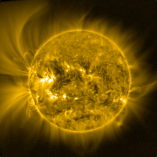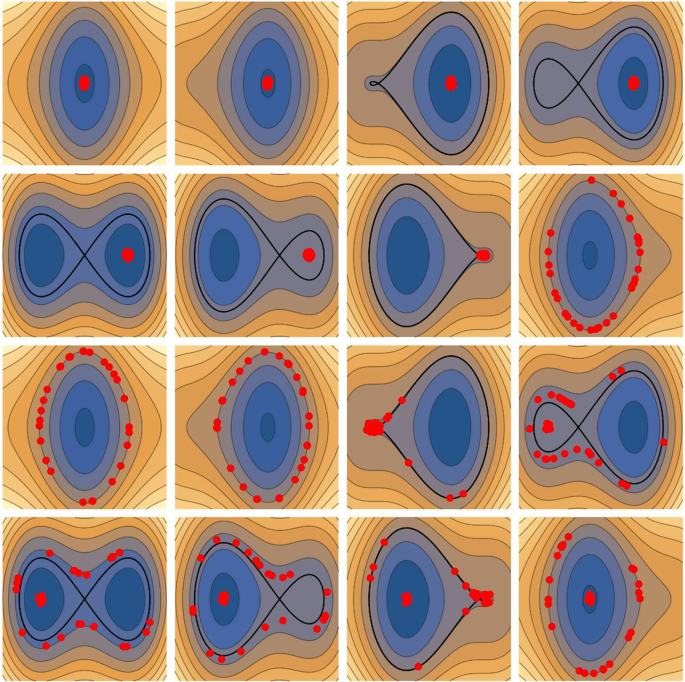Solar corona heating
Applying neo-adiabatic theory to ion heating mechanism in the solar corona. Picture by ©ESA.
Related publication: Escande, D.F., Gondret, V. & Sattin, F. Relevant heating of the quiet solar corona by Alfvén waves: a result of adiabaticity breakdown. Sci Rep 9, 14274 (2019). PDF or HTML.
 An open question in plasma physics lies in elucidating the reason behind the solar corona’s temperature, which is several orders of magnitude higher than the photosphere. Among the various contenders for explaining this heating phenomenon, Alfvén waves - travelling oscillations of ions and magnetic field - appear to be an efficient mechanism .
An open question in plasma physics lies in elucidating the reason behind the solar corona’s temperature, which is several orders of magnitude higher than the photosphere. Among the various contenders for explaining this heating phenomenon, Alfvén waves - travelling oscillations of ions and magnetic field - appear to be an efficient mechanism .
In the begining of the 2000s, Chen, Lin and White derived a heating process when the Alfvén wave frequency \(\omega\) is much smaller than the cyclotron frequency \(\Omega\), but still much larger than its coronal value. Our finding is that, no matter the ration of \(\omega/\Omega\) small, heating occurs whenever the amplitude of the Alfvén wave overcome a given threshold. Indeed, the effective ion dynamics is one-dimensional and is generated by the dimensionless Hamiltonian $H$,
\begin{equation}
H = \frac{p^2}{2}+\frac{x^2}{2} - A\sin(x - \omega t)
\end{equation}
where $x$ and $p$ are position and momentum of the ion and $A$ is the dimensionless Alfvén wave amplitude. The associated potential to this Hamiltonian $H$ is that of a harmonic oscillator modulated by a sinusoidal term.
When $A>1$, a slowly pulsating separatrix emerges in the phase space at the frequency $\omega$, which ions orbits are shown to periodically intersect. Near the separatrix, the associated period diverges and adiabatic theory no longer holds. The adiabatic invariant associated with the orbits undergoes a jump, leading to exponential divergence between two nearby orbits, which is indicative of chaos. Those jumps were studied and developed within the framework of the so-called neo-adiabatic theory, developed in the mid-eighties .
Values from the litterature able to show that the dimensionless Alfvén wave amplitude $A$ is of order unity . This means that a slowly pulsating separatrix is at stake in this context. The figure below tries to emphasize this phenomenon. When a separatrix is present (black curve), an initial bunch of nearby low-energy particles (red dots) is split into two distinct groups with very different energies after only two wave periods. In the latter reference, we proposed the following mechanism to explain the observed temperature of the solar corona.
The protocol we propose is the following: Alfvén waves are continuously produced and quenched by transferring their whole energy to ions. This permanent quenching would explain why the energy flux in the quiet corona corresponds to the whole energy budget, and not more, in the work by McIntosh et al.
Separation in energy reached by abrupt separation of orbits. Frames show snapshots at increasing times (from left to right and from top to bottom) of the phase-space (x, p) position of a bunch of particles (red dots). The contour levels are those of $H$. Particles are initialized close to the origin; they stay grouped together until the lobe disappears (7 th frame); then distribute along the iso-energy level. After the lobe and the separatrix reappear (11 th frame), particles are separated into two distinct groups, one with the original energy, and another with a higher energy.
 An open question in plasma physics lies in elucidating the reason behind the solar corona’s temperature, which is several orders of magnitude higher than the photosphere. Among the various contenders for explaining this heating phenomenon, Alfvén waves - travelling oscillations of ions and magnetic field - appear to be an efficient mechanism
An open question in plasma physics lies in elucidating the reason behind the solar corona’s temperature, which is several orders of magnitude higher than the photosphere. Among the various contenders for explaining this heating phenomenon, Alfvén waves - travelling oscillations of ions and magnetic field - appear to be an efficient mechanism 